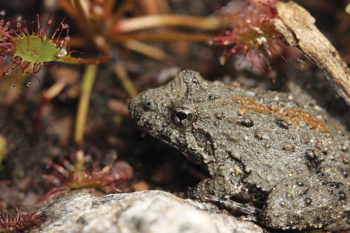
There are many different kinds of gardens — vegetable gardens, flower gardens, rock gardens, butterfly gardens and, of course, water gardens, just to name a few. But a type of garden that many people do not regularly consider is a bog garden, or gardening with plants that like “wet feet.” Bog gardens are normally associated with a water garden, as they’re typically right next to one or a part of its edge. However, they can stand alone and be unique gardens themselves. This type of garden in nature is similar to a marsh, with all the plants that like to grow there. However, the marshes or bogs in our landscapes are created by retaining water with a membrane.
Bog Gardens 101
Bog gardening is different from water gardening in several ways. Plants in a bog garden normally like wet feet, so to speak, for most of the year, but they do best with only a little water over the crown. More than 2 to 3 inches of water over their crowns is not tolerated for very long, depending on the variety of plant. They can take periodic flooding for short periods when most of the plant is under water, but only for a few days or so. Typically, these plants cannot tolerate dry soil at all. Most bog plants are herbaceous, which means that they die back to the ground in freezing weather.
An aspect that is critical for the health of all plants, including bog plants, is that their roots need oxygen. Aerated water contains dissolved oxygen and is vital for the plants’ roots. Decomposing organic matter uses up oxygen at a rate that is dependent on temperature and the present bacteria. In fertile soils, there is always organic matter, so as water flows through them, the oxygen is used for decomposition. If the flow of water is stopped due to restricted drainage, oxygen levels will drop, the soils will become stagnant and the plant roots will slowly die. So, we want to create some water flow through and around the soil. In a natural bog, there is always some drainage through the soil, since there is not a membrane or liner that contains the water.
A bog needs to be shallow enough for water to flow over plant crowns. In deeper bogs, the water should slowly flow through the root systems. The slow flow of water can be accomplished by punching holes in the membrane that contains the bog soil. Alternatively, you can install a drainage system that can be monitored and drained at periodic intervals. Personally, I like to punch the holes, but the confusing part is determining how many holes are enough.
Edging & Standalone Bogs
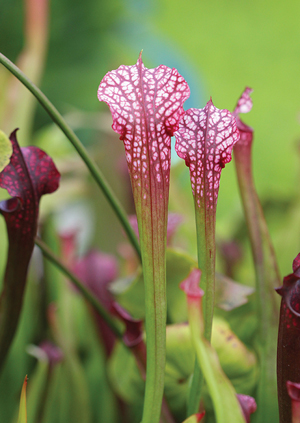
I consider bogs next to ponds that share the water of the pond more of an edging bog. These are relatively shallow, and the water flows over the plant crowns. This flow of water brings the necessary oxygen to the plant roots. There are no holes in the bottom of this type of bog, since they share water with the pond.
Bogs that stand alone or serve as an overflow point should have holes cut into the membrane that contains the soil. Cut holes that measure ¼ to 3/8 inches about every 2 to 3 square feet. If the surrounding soil does not drain well, like heavy clay for example, more holes can be cut. But if the soil is sandy, fewer holes will be necessary. If you are unsure of how many holes to create, cut just a few and see how quickly the water drains. You can always punch more holes by hammering ½-inch rebar down through the soil mix and into the membrane. You will want the soil to be consistently moist, with standing water draining away within a week or less.
Standalone bogs are perfect in a low spot in a landscape. I would never site a water garden in this area, because one heavy rainstorm would dump too much water at once, altering the water chemistry drastically. This type of standalone bog would be considered more of a rain garden. Depending on the situation, these may not need a membrane to retain the water, since they may have a constant source of water.
Prepping the Groundwork
Bog plants need at least 50 percent sunlight. These plants have evolved in full-sun conditions, so we should attempt to duplicate those conditions as closely as possible. You should dig the bog at least 12 inches deep, but I actually prefer a depth of 18 to 24 inches. This allows the bog to have access to more nutrients over a longer period of time. Like I mentioned earlier, it can be a standalone bog or situated next to a water garden. If given a choice, I prefer to site them as though they are part of the water garden, as an edge or the overflow point on the far edge of a pool.
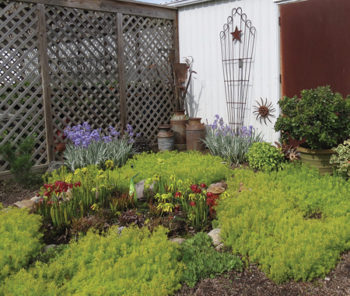
few species of Sarracenia, sundew and others.
For the membrane, I like to use old, repurposed EPDM 40-mil liner for both the standalone and the overflow bogs. If there happens to be a few holes, this is OK as long as there are only a few. As an alternative, you can use two layers of 6-mil black poly plastic. As long as it is covered by your mixed soil and not exposed to UV rays from sunlight, it will last many years. However, if I had a choice and a few extra dollars, I would always use the EPDM, since it is more durable without being that much more expensive.
The planting soil for traditional bogs and their plants should be a simple ratio of equal parts garden soil, peat moss, sharp sand or washed grit, and genuine compost. These components need to be mixed completely before being added to the bog. Place a 2-inch layer of ¾-inch washed granite rock at the very bottom of the bog before adding your soil mixture. This allows the water to flow to the holes.
Ideal Plantings
Good plants to use would be cardinal flower, blue lobelia and marsh marigold, to name a few. Varieties of plants that are considered invasive or aggressive need to be avoided. Most bog grasses are invasive; however, there are a few grass-like plants like golden sedge that work very well. All cattail varieties and equisetums will take over a bog after a few years, so avoid these — unless you want that, of course.
Keep in mind that any plant that is not invasive will be quickly overrun by the more aggressive plants and will die out. Avoid Iris pseudacorus, but most other iris species would probably be OK. I have tried to contain aggressive varieties of plants by planting them in pots that have holes in the bottom. As mentioned earlier, the plant roots still need drainage and access to moisture. However, the rhizomes of most of these plants will find the holes and escape, so they should be closely monitored if you choose this route.
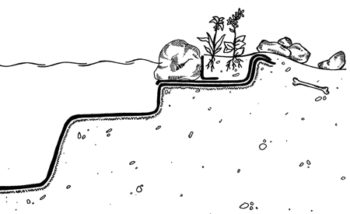
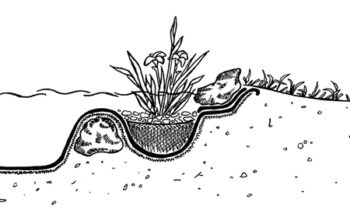
[box]These two drawings are relatively shallow, with water flowing over their plant crowns. This allows oxygen to reach the roots of the bog plants. There are no holes in the liner of the bogs shown in the bottom two drawings.[/box]
Bogs that have invasive plants purposely planted in them can actually have an interesting beauty in their own way. Try planting many varieties of aggressive plants and observe the results. You’ll find that the plants really “duke it out” (my friendly expression). Let the most aggressive plants in this situation win. Usually there are two or three that will become dominant. In these duke-it-out bogs, I would not waste any money and time on adding non-aggressive plants. The limits of the bog itself will contain these plants, so their aggressiveness will be tamed. These invasive bogs will need very little weeding, since every available square inch will be occupied by plants.
An absolutely beautiful standalone bog can be created for carnivorous plants. These plants, as most of you may know, get a lot of their nutrients from consuming insects that they catch in various ways. Just learning the different techniques that these plants use to capture insects is captivating, and being able to watch them in action adds to the lure of creating a carnivorous bog. Plants like Venus flytraps, sundews and various Sarracenia varieties are fun and absolutely beautiful. Some varieties can become large and potentially outcompete the smaller plants.
Soil Preservation
The soil of a carnivorous plant bog needs to be on the acidic side. According to a very experienced bog creator, Bob Briggs of Lincoln View Farm in Ames, Iowa, you should use three parts peat moss to one part medium poultry grit. This grit needs to be a sharp, insoluble stone. Of course, these components need to be mixed well before being adding to the created bog. The grit allows the oxygen an additional way to reach the plant roots. This soil mix is one of the only different options as far as the design goes. You will still need the drainage and the depth.
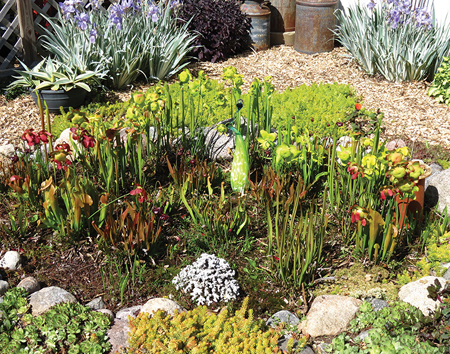
To overwinter these plants here in the Midwest, Bob says to mulch with a 6-inch layer of coarse leaves, cattail straw or soybean straw. Most of these carnivorous species are marginally hardy for us, but they will do fine with the mulch. For those in warmer regions, you’re lucky not to have to worry so much about this.
Just like any perennial bed, bogs will need to be kept weeded. Some of the duke-it-out bogs will need less weeding than others, since almost all the space will be taken up by plants. Plant your bogs heavily, and there will be fewer weeds. Weeds pull easily from the muddy soil, but use caution to avoid inadvertently pulling up some of the more delicate, smaller bog plants. It is also difficult to walk in your bog, so create narrow bogs whose centers can be easily reached. You can also use stepping stones in wider bogs. As the organic matter of the bog decomposes over time, periodic additions of compost mixed with peat moss can be used to top it off. In carnivorous gardens, use only peat moss.
Bog gardens are a unique way of gardening that most gardeners have not yet explored. Whether you use carnivorous plants, duke-it-out aggressive plants or marginal plants that are difficult to grow in deeper water, the choices are many, and the results can be quite rewarding.



Very helpful. Why granite rock? Would pond pebbles be good?
Hi Gina
Yes “pond pebbles” would be okay as long as they are 3/4 inch to 1 inch in diameter. You are wanting to allow water to flow freely to the drainage holes.
Have fun bog gardening. Jamie